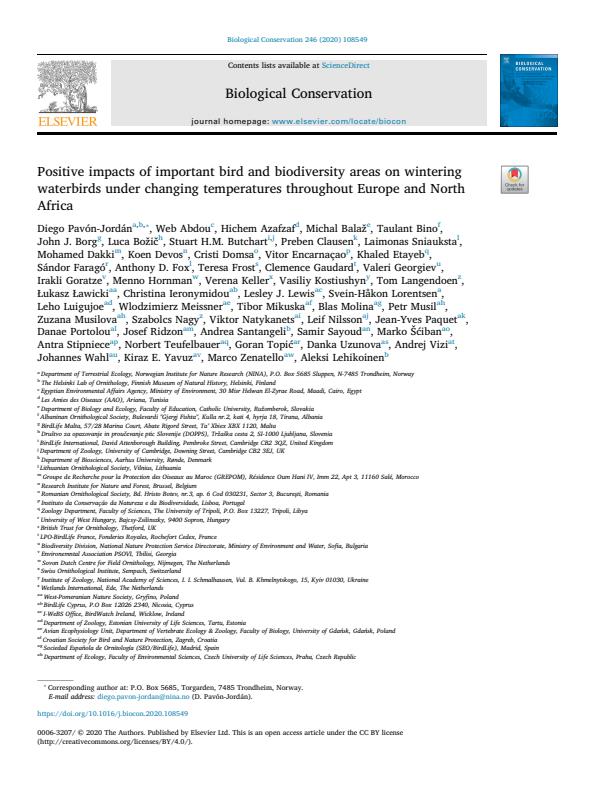Positive impacts of important bird and biodiversity areas on wintering waterbirds under changing temperatures throughout Europe and North Africa
Details
| Aantal pagina's | 1 |
|---|---|
| Volume | 246 |
| Pagina's (van-tot) | 108549 |
| Type | A1: Web of Science-artikel |
| Categorie | Onderzoek |
| Tijdschrift | Biological Conservation |
| Issns | 0006-3207|1873-2917 |
| Uitgeverij | Applied Science Publishers |
| Taal | Engels |
Bibtex
@misc{98a84747-361c-4886-ac83-80d5ecaf5ba7,
title = "Positive impacts of important bird and biodiversity areas on wintering waterbirds under changing temperatures throughout Europe and North Africa",
abstract = "Migratory waterbirds require an effectively conserved cohesive network of wetland areas throughout their range and life-cycle. Under rapid climate change, protected area (PA) networks need to be able to accommodate climate-driven range shifts in wildlife if they are to continue to be effective in the future. Thus, we investigated geographical variation in the relationship between local temperature anomaly and the abundance of 61 waterbird species during the wintering season across Europe and North Africa during 1990–2015. We also compared the spatio-temporal effects on abundance of sites designated as PAs, Important Bird and Biodiversity Areas (IBAs), both, or neither designation (Unlisted). Waterbird abundance was positively correlated with temperature anomaly, with this pattern being strongest towards north and east Europe. Waterbird abundance was higher inside IBAs, whether they were legally protected or not. Trends in waterbird abundance were also consistently more positive inside both protected and unprotected IBAs across the whole study region, and were positive in Unlisted wetlands in southwestern Europe and North Africa. These results suggest that IBAs are important sites for wintering waterbirds, but also that populations are shifting to unprotected wetlands (some of which are IBAs). Such IBAs may therefore represent robust candidate sites to expand the network of legally protected wetlands under climate change in north-eastern Europe. These results underscore the need for monitoring to understand how the effectiveness of site networks is changing under climate change.",
author = "Diego Pavón‐Jordán and Web Abdou and Hichem Azafzaf and Michal Balaž and Taulant Bino and John J. Borg and Luca Božič and Stuart H.M. Butchart and Preben Clausen and Laimonas Sniauksta and Mohamed Dakki and Koenraad Devos and Cristi Domsa and Vitor Encarnaçao and Khaled Etayeb and Sándor Faragó and Anthony David Fox and Teresa Frost and Clemence Gaudard and Valeri Georgiev and Irakli Goratze and Menno Hornman and Verena Keller and Vasiliy Kostiushyn and Tom Langendoen and Łukasz Ławicki and Christina Ieronymidou and Lesley J. Lewis and Svein-Håkon Lorentsen and Leho Luigujoe and Wlodzimierz Meissner and Tibor Mikuska and Blas Molina and Petr Musil and Zuzana Musilova and Szabolcs Nagy and Viktor Natykanets and Leif Nilsson and Jean-Yves Paquet and Danae Portolou and Josef Ridzon and Andrea Santangeli and Samir Sayoud and Marko Šćiban and Antra Stipniece and Norbert Teufelbauer and Goran Topić and Danka Uzunova and Andrej Vizi and Johannes Wahl and Kiraz E. Yavuz and Marco Zenatello and Aleksi Lehikoinen",
year = "2020",
month = jun,
day = "01",
doi = "https://doi.org/10.1016/j.biocon.2020.108549",
language = "Nederlands",
publisher = "Applied Science Publishers",
address = "België,
type = "Other"
}
Auteurs
Diego Pavón‐JordánWeb Abdou
Hichem Azafzaf
Michal Balaž
Taulant Bino
John J. Borg
Luca Božič
Stuart H.M. Butchart
Preben Clausen
Laimonas Sniauksta
Mohamed Dakki
Koen Devos
Cristi Domsa
Vitor Encarnaçao
Khaled Etayeb
Sándor Faragó
Anthony David Fox
Teresa Frost
Clemence Gaudard
Valeri Georgiev
Irakli Goratze
Menno Hornman
Verena Keller
Vasiliy Kostiushyn
Tom Langendoen
Łukasz Ławicki
Christina Ieronymidou
Lesley J. Lewis
Svein-Håkon Lorentsen
Leho Luigujoe
Wlodzimierz Meissner
Tibor Mikuska
Blas Molina
Petr Musil
Zuzana Musilova
Szabolcs Nagy
Viktor Natykanets
Leif Nilsson
Jean-Yves Paquet
Danae Portolou
Josef Ridzon
Andrea Santangeli
Samir Sayoud
Marko Šćiban
Antra Stipniece
Norbert Teufelbauer
Goran Topić
Danka Uzunova
Andrej Vizi
Johannes Wahl
Kiraz E. Yavuz
Marco Zenatello
Aleksi Lehikoinen

